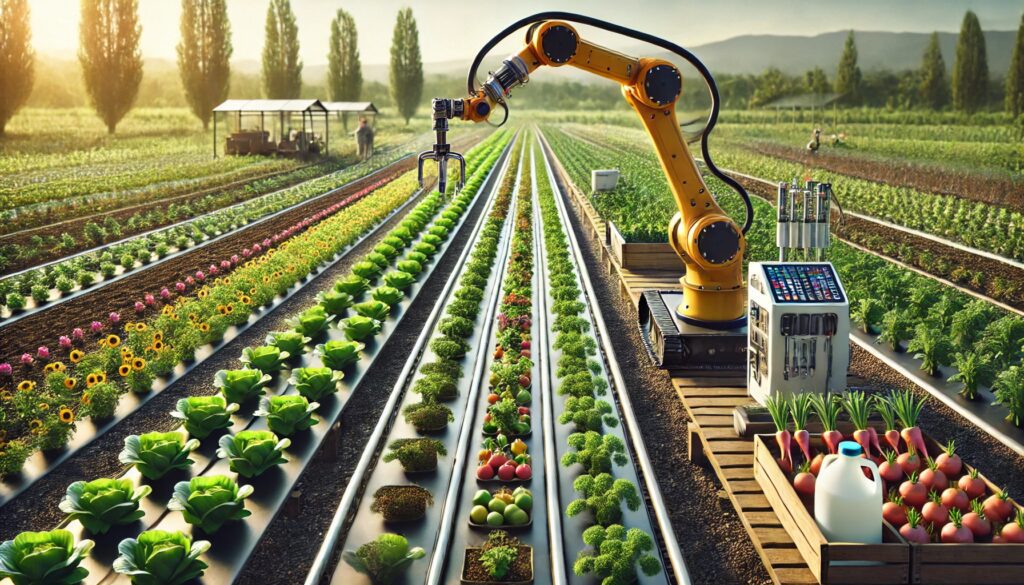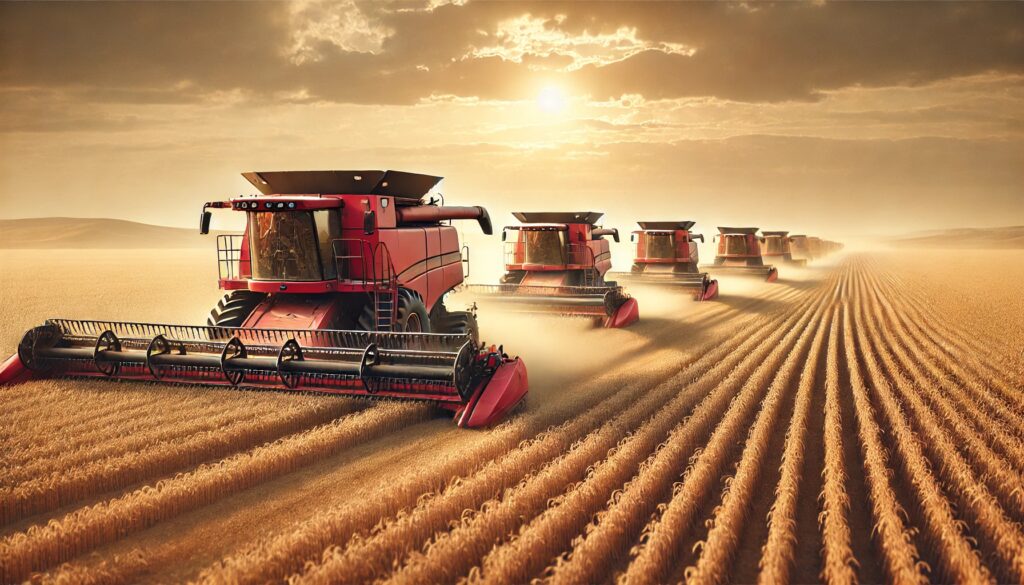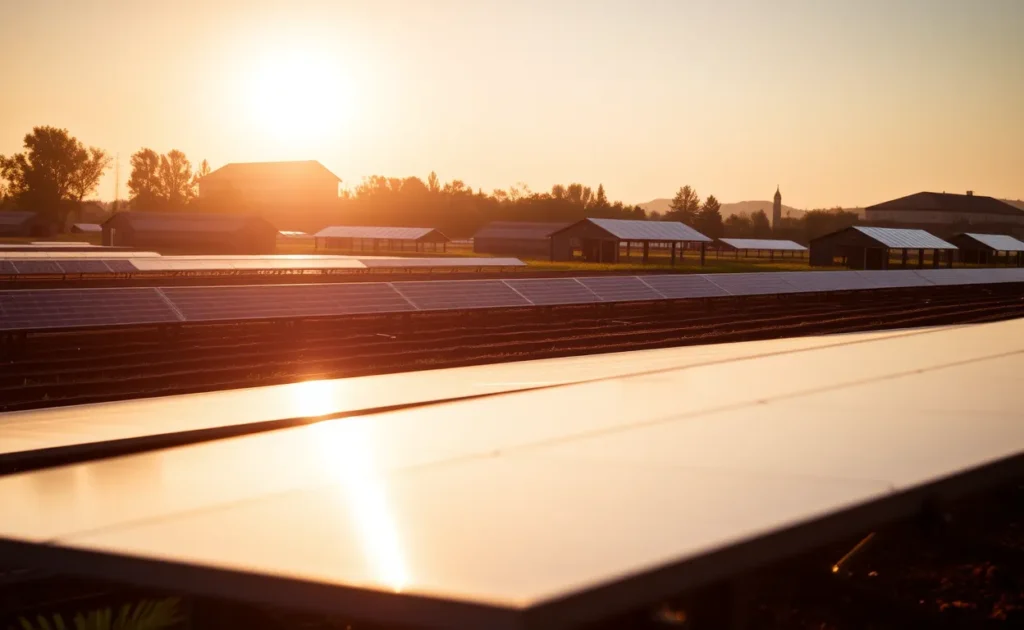
How Agrivoltaics Revolutionizes Farming and Energy
Dual Use of Land: A Sustainable Solution
Agrivoltaics combines solar power and agriculture on the same plot of land. It’s a win-win for energy and food production.
Solar panels are mounted above farmland, shading crops and producing renewable energy. This dual use reduces competition for land, addressing growing global demands for food and clean energy.
Studies show shaded crops can thrive in hot climates. Crops like lettuce, tomatoes, and peppers benefit from moderated temperatures and reduced water evaporation.
Water Efficiency and Climate Resilience
Water usage in agriculture is a big deal, especially in arid regions. Agrivoltaics tackles this issue head-on.
Solar panels reduce soil water evaporation by providing partial shade. This means farmers need less irrigation, which is both cost-effective and eco-friendly.
Rainwater harvesting is another plus. Panels can channel water into storage systems, ensuring a reliable supply for crops.
Enhanced Energy Yield from AI Monitoring
Artificial intelligence plays a crucial role in optimizing agrivoltaics. AI monitors weather patterns and adjusts panel angles to maximize energy output.
Smart systems can predict and balance energy production and usage. This keeps the solar farm running efficiently without compromising farming needs.
AI-powered drones also monitor crop health, spotting issues like pests or diseases before they become big problems.
Supporting Biodiversity and Soil Health
Agrivoltaics encourages diverse plant growth beneath solar panels. Ground cover crops reduce soil erosion and add nutrients back into the earth.
The shaded environment can attract pollinators like bees, which boost crop yields and local ecosystems.
This synergy makes agrivoltaics an ally in restoring biodiversity, especially in areas heavily affected by monoculture farming.
Economic Opportunities for Farmers
By hosting solar panels, farmers can earn an extra income through energy production. This financial cushion is especially helpful during tough growing seasons.
Agrivoltaic setups can attract government subsidies or incentives aimed at promoting renewable energy.
Combining agriculture and energy creates jobs, from installation to maintenance, diversifying rural economies.
The Role of AI in Scaling Agrivoltaic Systems Globally
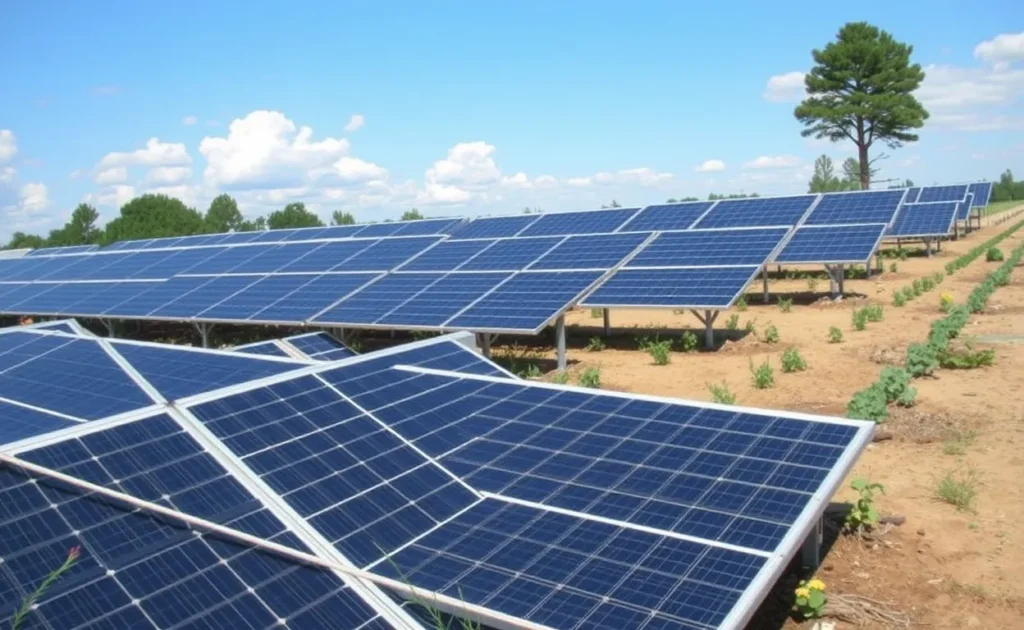
Smart Data for Precision Farming and Energy Management
AI’s capacity for real-time data analysis makes agrivoltaics scalable and efficient.
Using machine learning, AI analyzes weather, soil conditions, and crop health. This allows for targeted interventions, minimizing resource waste.
Energy production can also be synced with local grids. AI ensures surplus solar energy from agrivoltaic farms is distributed efficiently, reducing power shortages.
Optimizing Panel Layout for Maximum Yield
AI simulations can model the ideal placement of solar panels to optimize both crop growth and energy production.
These tools consider factors like sunlight angles, crop species, and land topography. Farmers benefit from tailored designs that maximize land use.
Dynamic shading systems controlled by AI can adjust panel positions based on sunlight intensity, offering flexibility during seasonal changes.
Integrating Agrivoltaics into Urban Food Systems
Urban farming meets renewable energy with rooftop agrivoltaic setups. Cities benefit from local food production and clean energy without taking up extra land.
AI-powered systems track microclimates across urban spaces, identifying the best locations for agrivoltaic projects.
This integration supports food security in urban areas while contributing to the renewable energy mix in densely populated regions.
Challenges of Global Implementation
Despite the promise, scaling agrivoltaics globally faces hurdles like cost, policy gaps, and public awareness.
AI-driven models help address these challenges by providing accurate forecasts of costs and returns. Governments can use this data to craft incentives and subsidies.
Educating farmers and stakeholders about the benefits is another area where AI tools, like virtual reality simulations, can make an impact.
Synergy with Other Renewable Technologies
Agrivoltaics doesn’t operate in isolation. It works seamlessly with other green technologies like wind power and battery storage.
AI can coordinate multiple energy sources, ensuring reliability and balance in hybrid renewable systems.
For example, during low solar output, AI shifts energy reliance to wind or stored reserves, maintaining consistency in power supply.
Future Trends in Agrivoltaics and AI Integration
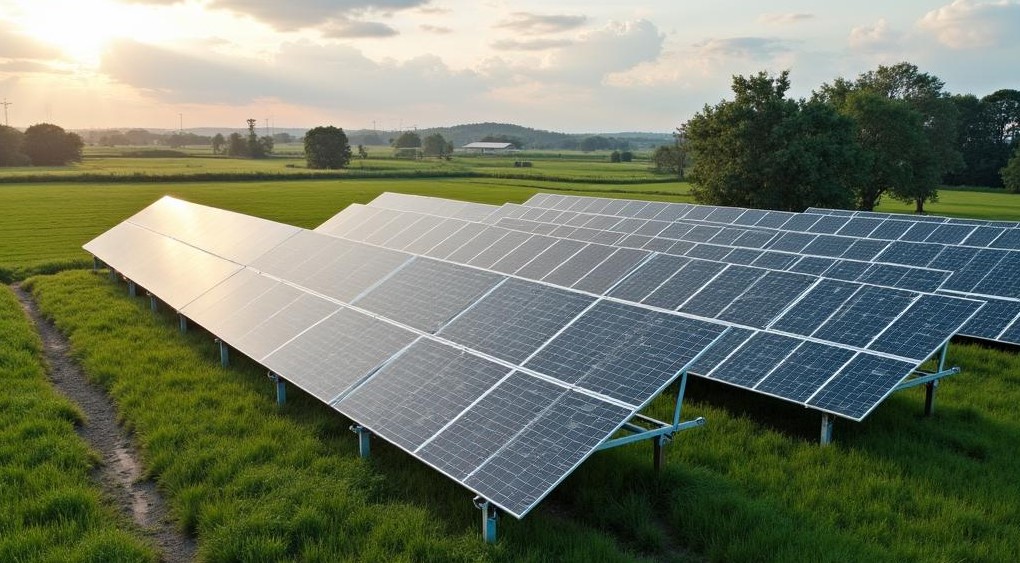
Advanced AI Applications in Agrivoltaics
AI continues to revolutionize agrivoltaic systems with cutting-edge technologies designed for efficiency and growth.
Emerging AI tools can simulate long-term climate impacts on agrivoltaic farms. By predicting changes in temperature, rainfall, and sunlight, farmers can adapt planting and harvesting schedules for better yields.
Autonomous robots are on the rise. These AI-driven machines manage tasks like soil monitoring, crop harvesting, and even cleaning solar panels, reducing labor costs and improving efficiency.
Innovations in Agrivoltaic Panel Design
The future of solar panels in agrivoltaics is adaptive. Semi-transparent panels allow more sunlight to pass through, supporting light-sensitive crops.
AI-assisted materials science is helping develop panels with adjustable transparency. This ensures optimal lighting for crops and energy production at different times of the day.
Floating agrivoltaics, a promising trend for regions with limited land, combines water-based farming with energy generation. AI helps manage water quality and panel orientation for maximum output.
Agrivoltaics in Developing Regions
Agrivoltaics offers transformative potential for developing countries facing food and energy shortages.
Low-cost, AI-powered systems can optimize energy production while improving agricultural yields, addressing two critical challenges simultaneously.
Organizations like the International Renewable Energy Agency (IRENA) are already funding projects in regions like Africa and Southeast Asia, where agrivoltaics can thrive in high-sunlight environments.
Climate Change Mitigation with Agrivoltaics
Agrivoltaics directly contributes to combating climate change by reducing carbon emissions from traditional farming and energy generation.
AI enhances this impact by improving system efficiency. For example, machine learning algorithms predict the best times for energy storage, ensuring minimal waste.
The technology also supports regenerative farming practices, such as intercropping and carbon sequestration, creating a sustainable cycle that benefits the environment.
Shaping Global Sustainability Goals
Agrivoltaics aligns perfectly with global initiatives like the UN Sustainable Development Goals (SDGs).
The combination of renewable energy and sustainable agriculture contributes to goals like affordable clean energy (SDG 7), zero hunger (SDG 2), and climate action (SDG 13).
AI’s ability to optimize these systems ensures scalability, making agrivoltaics a cornerstone in the transition to a greener, more resilient future.
Conclusion
Agrivoltaics, powered by AI, bridges the gap between renewable energy and sustainable agriculture. Its innovative approach to land use, water efficiency, and energy production addresses critical global challenges. With advancements in technology and growing interest worldwide, this synergy has the potential to reshape food systems, boost renewable energy adoption, and pave the way for a sustainable future.
Recent Developments in Agrivoltaics and AI Integration
The field of agrivoltaics—combining solar energy production with agriculture—has seen significant advancements recently, particularly with the integration of artificial intelligence (AI).
AI-Driven Optimization in Agrivoltaics
AI and machine learning are revolutionizing agrivoltaic systems by optimizing the interaction between solar panels and agricultural activities. Advanced algorithms analyze vast amounts of data, including weather patterns, soil conditions, and crop health, to enhance both energy production and crop yields. For instance, AI can dynamically adjust panel angles to maximize sunlight exposure while providing optimal shading for crops, leading to improved efficiency and productivity.
Innovative Applications of AI in Agrivoltaics
French agrivoltaics specialist GLHD has developed an augmented reality application that utilizes AI technology for landscape integration. This tool allows users to visualize agrivoltaic structures within a given landscape, facilitating better planning and community engagement. By displaying fixed structures or trackers in real-time, stakeholders can assess the visual impact and integration of agrivoltaic projects more effectively.
Economic and Environmental Benefits
The integration of AI in agrivoltaics not only enhances operational efficiency but also offers economic advantages. For example, the practice of solar grazing—using livestock like sheep to manage vegetation under solar panels—has gained traction in the U.S. This approach reduces maintenance costs and provides additional income streams for farmers. AI can further optimize this practice by monitoring grazing patterns and ensuring the health of both the livestock and the crops.
Global Potential and Policy Implications
A report by the European Commission’s Joint Research Centre highlights that covering just 1% of the EU’s utilized agricultural area with agrivoltaic systems could result in approximately 944 GW of installed capacity. This finding underscores the significant potential of agrivoltaics in contributing to renewable energy targets. The integration of AI can facilitate this expansion by providing data-driven insights for optimal site selection and system design.
These developments illustrate the transformative impact of AI on agrivoltaic systems, paving the way for more sustainable and efficient agricultural and energy practices worldwide.
FAQs
What role do pollinators play in agrivoltaics?
Pollinators like bees and butterflies are crucial in agrivoltaics. By planting pollinator-friendly ground covers beneath solar panels, these systems attract beneficial insects that enhance crop yields.
For example, some agrivoltaic farms use wildflowers as ground cover, which not only improves soil health but also creates habitats for pollinators. This boosts agricultural productivity while supporting biodiversity.
Are there economic benefits for farmers adopting agrivoltaics?
Absolutely. Farmers earn additional income by producing and selling solar energy, providing a financial buffer during challenging agricultural seasons.
In states like Colorado, USA, some farmers have reduced irrigation costs thanks to the shade from solar panels. They’ve also qualified for government subsidies promoting renewable energy, which further offsets initial installation costs.
Agrivoltaics transforms farmland into a dual-income source, balancing energy generation with food production.
Is agrivoltaics feasible in areas with extreme weather?
Yes, agrivoltaics can perform well in regions with extreme weather conditions, thanks to AI and adaptive designs. For example, solar panels can act as protective shields against hail, heavy rain, or intense sunlight, reducing crop damage.
In areas prone to drought, agrivoltaics conserves water by reducing evaporation and enabling rainwater harvesting. Farmers in hot climates, like parts of India, have successfully grown crops under solar arrays while generating energy for irrigation systems.
How does agrivoltaics help with water management?
Agrivoltaics significantly improves water efficiency by providing shade, which reduces evaporation from the soil. This is especially helpful in water-scarce regions.
Additionally, solar panels can be designed to capture and redirect rainwater into storage tanks. For example, farms in Japan have implemented systems where collected water irrigates crops during dry periods, lowering dependence on external water sources.
Are there government incentives for adopting agrivoltaics?
Many governments worldwide offer subsidies or tax breaks to encourage agrivoltaic adoption. For instance, in the EU, the Common Agricultural Policy (CAP) supports agrivoltaic projects to promote renewable energy and sustainable farming.
In the United States, states like California and Oregon provide grants for dual-use projects. Farmers also qualify for renewable energy credits, further offsetting costs.
How does agrivoltaics compare to traditional solar farms?
Unlike traditional solar farms, which often displace agricultural activities, agrivoltaics integrates energy production with farming. This dual use optimizes land resources, making it a better option in areas where land is scarce.
Traditional solar farms can contribute to habitat loss, whereas agrivoltaics fosters biodiversity by planting ground covers and encouraging pollinator activity. It’s a more sustainable and community-friendly solution.
Can livestock be integrated into agrivoltaic systems?
Yes, livestock like sheep or goats are often included in agrivoltaic systems. These animals graze beneath the solar panels, naturally controlling vegetation and reducing the need for mowing or chemical herbicides.
For example, in France, sheep grazing under solar panels has become a common practice. The animals benefit from shaded areas during hot summers while maintaining the land. It’s a practical and eco-friendly solution for managing vegetation.
What are some real-world examples of successful agrivoltaic projects?
Several countries have implemented agrivoltaics with great success. In Germany, Fraunhofer ISE developed a project where apples and berries were grown under solar panels, leading to higher yields and energy generation.
In the U.S., Jack’s Solar Garden in Colorado combines solar power with community-supported agriculture, producing both crops and renewable energy for local use.
In Kenya, solar-powered drip irrigation systems under agrivoltaic setups have revolutionized farming in arid regions, enabling smallholder farmers to increase food production sustainably.
How can AI help farmers transition to agrivoltaics?
AI-powered tools simplify the transition by providing tailored recommendations for panel placement, crop selection, and irrigation management. For instance, AI platforms can simulate farm layouts to balance energy generation and crop productivity.
Farmers can also use predictive models to understand long-term costs and benefits, making it easier to secure funding or investments for agrivoltaic systems. Drones equipped with AI are used to survey land and monitor soil health, ensuring a smoother transition.

